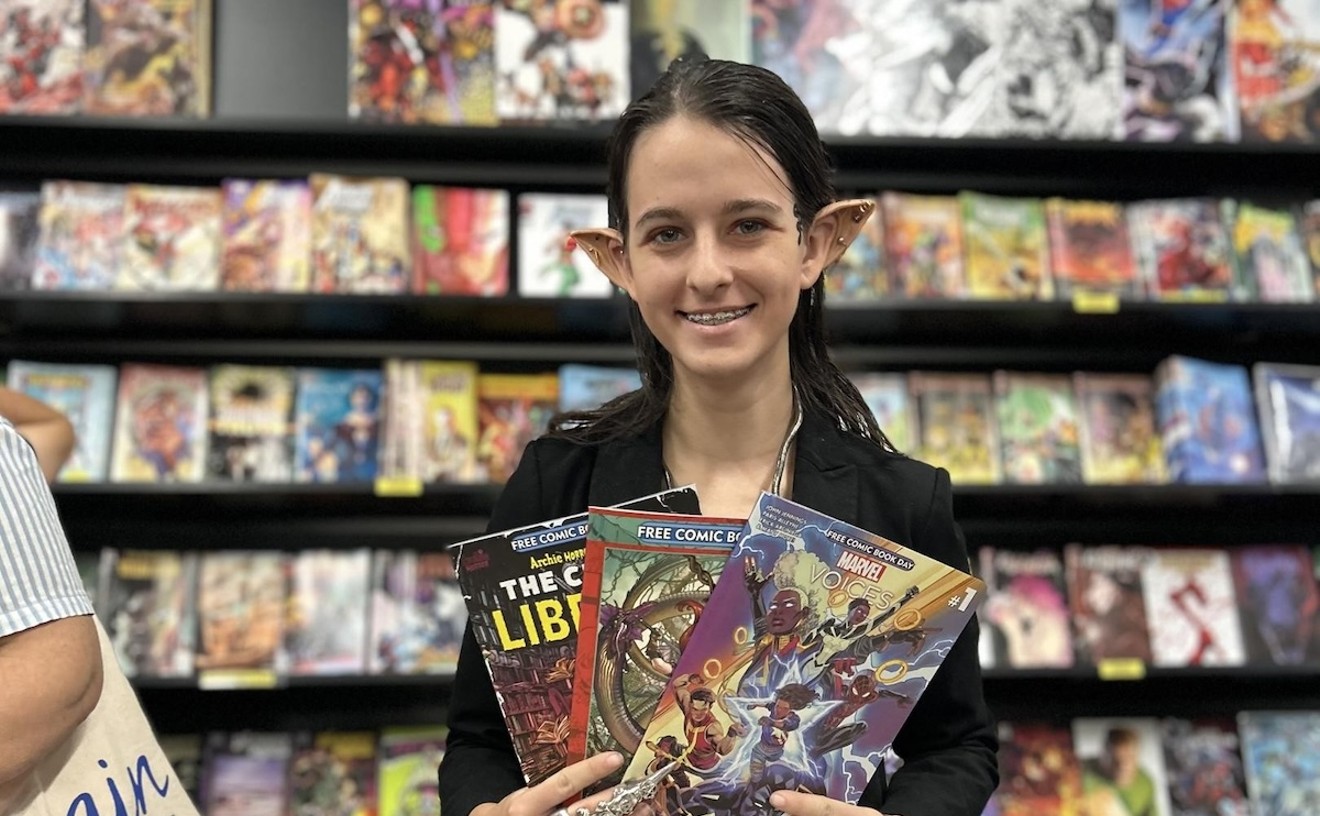This is a loose chronology of the events that led up to the dismantling of the exhibit and a leap backward on our road to maturity. On April 26, coinciding with Little Havana's Cultural Fridays, Beltrán's "Centennial" opened at Maxoly to a big turnout. An inconspicuous visitor mingling among the crowd that evening was Miguel Saavedra, Jr., the leader of the right-wing exile group Vigilia Mambisa.
Over the next four days, anonymous callers complained to station Radio Mambí (WAQI-AM 710) that Beltrán's show was an insult to the exile community. The exhibit was labeled "pro-Castro" and other such inflammatory-for-Miami epithets. On Wednesday, May 1, around twenty members of Vigilia Mambisa showed up to picket outside Maxoly, carrying banners and flags and shouting obscenities at Maximo Sarracino, the gallery's owner, and his guests. Miguel Saavedra led the vociferous group in demanding Beltrán and Sarracino make immediate changes to the show.
As one of Sarracino's friends left the gallery for El Pub across the street, he was prevented from entering the restaurant and pushed around, his jacket ripped. This painter did not want his name used in print. Intimidation is a powerful force.
On Thursday morning Sarracino says he thought the windowpane of the gallery that faced Eighth Street had been shot at, leaving for him a menacing imprint. Later that day on an interview on WLTV-TV (Channel 23), Saavedra declared the paintings "insulting to the exile community" and vowed that Vigilia Mambisa would picket again on Saturday.
After reporting the incident to authorities and the media, Sarracino decided to sleep in the gallery to protect the work.
Needless to say, at no point had Saavedra contacted Beltrán in order to understand the intentions behind the artist's work.
Sometime after midnight Friday, Sarracino says he heard two shots from his back room. This time the window was shattered, but none of Beltrán's paintings was damaged. Sarracino installed a huge wood panel. The police are investigating but as of press time could not confirm any details and had no leads. That afternoon Vigilia Mambisa canceled the planned Saturday demonstration.
These disturbing events are highly ironic: When one really looks at Beltrán's work, one sees that it comes out of the sphere of political dissidence (he lives in Miami and has been a well-known Cuban artist for some time). The difficulty for some, apparently, is that understanding Beltrán's work isn't easy. His art is complex -- as it should be. A too-literal reading of Beltrán may give an impression that the artist defends some kind of political annexionism (taboo for Cuban nationalists of both the left and right variety), and therefore miss other, more subtle meaning. Take the Cuban flag, which the artist turns into a subtle conceptual cipher, suggesting shades of the political spectrum from patriotism to chauvinism. The Intruder shows a sort of penetration of the Cuban flag by the American one (they feature like colors), so they become a hybrid.
Beltrán's American Martí series draws on the image of the apostle of Cuban independence placed against the American ensign. The artist smartly plays off the old mantras of separatism and autonomy so much used by all Latin-American despots from right and left. In the end the demystifying work is conflicting for Cuban ultranationalists on both sides of the political divide.
Hope is a direct, graceful work, which borrows from Romantic and Socialist propaganda iconography. We see a frontal view of a naked woman wearing a green turban amid suggested bands of color of the Cuban flag. This is what is unique about Beltrán's work: He captures problematic issues of dogmatic political discourses on both sides of the Cuban divide and exposes them with a simple and direct pictography.
But over on Eighth Street subtlety and real discourse were not winning the day.
On Monday, May 6, Beltrán and Saavedra both appeared on WQBA-AM (1140), on Edmundo Garcia's popular Strangers in the Night. The program proved illuminating, revealing Saavedra's mentality and the power of slander -- and by extension, Vigilia Mambisa's censoring hand. After maintaining he didn't understand anything about art, Saavedra promptly contradicted himself, arguing about "what was wrong with the paintings." In a ludicrous paternalistic tone, Saavedra counseled Beltrán what to do "not to upset the exile community," and went on to suggest repainting the works, changing the titles, or painting other themes that he then proceeded to enumerate: rafts on the sea, Elian, Hitler's face, death squads, Castro dripped in red ... you get the point. Listening to Saavedra proclaiming to "protect the streets of Miami from musicians and artists trying to penetrate Miami" was an unsettling reminder of the psychology behind chauvinism and suppression.
The callers were almost equally divided on the issue (remember that WQBA, formerly La Cubanísima, still is a conservative radio station with an old-fashioned listener base). You would imagine one should see a show in order to condemn it, but when asked by Edmundo Garcia, those callers supporting Vigilia Mambisa had not done so. On the other hand those listeners supporting Beltrán's right to expression questioned Saavedra's intentions and his self-promoting position as a "voice" for the whole exile community.
At some point in the program it became clear that Saavedra took for granted that the shootings were carried out by pro-Castro elements (Beltrán himself did not necessarily disagree). As of yet no one knows who was behind the violence, so such an assertion, a priori, was wrong and dishonest -- even to the most impartial of listeners. Regardless of the right to protest, which Vigilia Mambisa may have abused, the vandalism perpetrated on Maxoly gallery is a dangerous reminder of the cost of extremism. Even in the seemingly bland and apolitical world of art, there must be a limit to provoking radicalism and then blaming Castro for the consequences. (Calls to Vigilia Mambisa were not returned.)
On Friday, May 10, Sarracino pulled down "The Centennial," two weeks before its closing date. He gave a vague response as the official reason, saying he had to fix up the damaged gallery "and get ready for the next exhibition." Unofficially we can assume Sarracino had no great interest in dodging more bullets or Mambisa members. What we do know is that when the paintings came down, intolerance won, over freedom of expression and just plain freedom.










